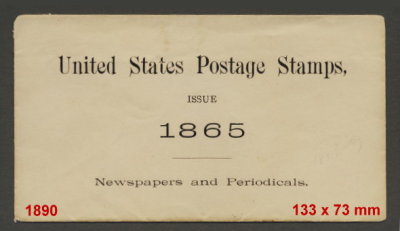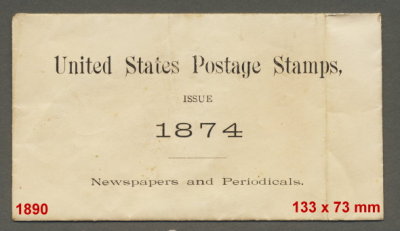The Proofs
Made to check designs before final printing (on India), or as presentation sets (on card). Designs usually started with essays that became die proofs and then finally plate proofs (on wove paper or India). The proofs on India and wove are "true" proofs in that they were used to help develop and check (proof) the final design. The "card" proofs were actually for presentation sets and there were five major printings of them. I do not believe PR2-4 proofs on wove paper actually exist, but are really the thinner 1882 card proofs. Since the Scott catalog does not make it clear there were two card printings in the PR2-4 colors, once a dealer has a card set on the thick card (obviously card), they assume the set they have on (very) thin card must be wove paper.Warning! Plate proofs (on India) when perforated can pass as original PR9-32s! See Counterfeits.
Newspaper Card Plate Proofs
There were 5 different major printings or "emissions" of the proofs on card in 1879, 1882, 1890, 1893, and1894. The sets differ marginally by shades and card thicknesses. With great help from researchers such as Greg Vaupotic and George Sayers, lots of reseach reading, studying over 1000 card proofs, and by buying full sets with their accompanying envelopes, I'm confident I have assembled 5 complete sets!
The 1879 and 1882 emissions could maybe be considered PR9-31 regular issue colors, while the 1890-4 emissions appear more like the 1879 colors of the regular issues, although the 9 cent value (PR 14) is retained from the first emission. It appears somewhere during the last three emissions, the 1885 "carmine" colors were used although each of the last three emissions kept all the dollar values as well as the 9 cent value and an added 1 cent value (now you go figure out how "off" this makes the plate proof listings in the Scott Specialized catalog).
Each emission came in two unique envelopes. One envelope held the 1865 issue (PR2-4) and one envelope held the 1874 issue (PR9-32). The five emissions can be identified by their envelopes which differered between the five emmisions. If the proofs have been seperated from their envelopes, there is hope of identifying the 1879 and 1882 emmisions, slight hope of figuring out the 1890 emmission, and little chance of distinguishing between an 1893 and 1894 emission. If you are very interested, with my reference sets, I might be able to help.


More information can be found in my publication
The Proofs.